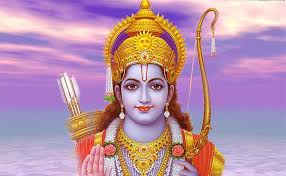
Sri Rama Navami
Sri Rama was born on Navami, the ninth day of the month of Chaitra, in the fourth quarter of the Punarvasu star. The birth of Sri Rama is celebrated as Ramajanmotsava. The birth of the Lord as purnavatara was to annihilate Asuras and restore dharma in the world. Though born in an affluent family, Rama lived and practiced dharma as a common man. He taught with his actions and not merely by his words.
There was a son named Narayana to poor Keshava Bhatta resident of Surapura. Keshava Bhatta was a staunch devotee of Rama. Once he set out on a nationwide pilgrimage carrying with him his standard box with usual puja materials, a copper pot, etc. After many days he met the three sages Vyasa, Parashara, and Shuka. He bowed down to them and related to them the difficulties he faced in life. The three sages advised him to perform discourses on the Sri Ramanavami ritual and observe it himself, and also, to give discourses on Ramayana.
The three sages explained the benefits of Sri Ramanavami puja as follows:-
“By observing this ritual one can secure the grace of Lakshmi, even foes would turn friends, one will be blessed with a healthy life and those without children would beget offspring”. Keshava Bhatta bowed down to them and returned home with a firm conviction to perform the Navami puja and also spread the greatness of this ritual through his pravachana (discourses).
As advised he observed the Sri Ramanavami ritual according to the prescribed procedure and was blessed with a long life filled with prosperity.
A poor married woman after listening to the discourse on the Sri Ramanavami ritual from Narayana, son of Keshava Bhatta, observed Ramanavami and was restored to her the husbandSri Ramanavami Vrata Puja who had deserted her and gone away to Kashi. Her son observing the Sri Ramanavami ritual became the ruler of a kingdom, when an elephant which was given a garland to select the successor the king who had died, selected him as the king.
Apart from the ritualistic puja to Sri Rama, Ramanavami marks the recital of Srimad Valmiki Ramayana (Narayana), usually commenced on Ugadi to be concluded on Navami day. Dasharatha the father of Rama is said to have welcomed the guests offering panaka (a drink prepared by adding jaggery with water), thin buttermilk, and giving fans when they came to greet him upon son’s birth. Hence the practice is followed to date. At the conclusion of the recital, Panaka (jaggery dissolved in water with the addition of cardamom, etc.), thin buttermilk, vada, soaked green gram dal with raw mango pieces, green chilies, and lemon juice are distributed to devotees.
Thus this ritual would not only bestow spiritual progress but also help a man lead a happy life with the grace of Lord Rama.
Rama Moola Mantra
ॐ श्री रामाय नमः॥
Om Shri Ramaya Namah॥
Rama Taraka Mantra
श्री राम जय राम जय जय राम॥
Shri Rama Jaya Rama Jaya Jaya Rama॥
Rama Gayatri Mantra
ॐ दाशरथये विद्महे सीतावल्लभाय धीमहि,
तन्नो राम प्रचोदयात्॥
Om Dasharathaye Vidmahe Sitavallabhaya Dhimahi,
Tanno Rama Prachodayat॥
Rama Meditation Mantra
ॐ आपदामपहर्तारम् दाताराम् सर्वसम्पदाम्।
लोकाभिरामम् श्रीरामम् भूयो-भूयो नमाम्यहम्॥
Om Apadamapahartaram Dataram Sarvasampadam।
Lokabhiramam Shriramam Bhuyo-Bhuyo Namamyaham॥
Ramaya ramabhadraya ramacandraya vedhase।
raghunathaya nathaya sitayaḥ pataye namaḥ॥2॥
रामाय रामभद्राय रामचन्द्राय वेधसे।
रघुनाथाय नाथाय सीतायाः पतये नमः॥२॥
